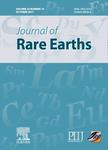Relaxation process and phase transition of lanthanide liquid crystalline complexes by photoacoustic spectroscopy
Relaxation process and phase transition of lanthanide liquid crystalline complexes by photoacoustic spectroscopy作者机构:Key Laboratory of Modern Acoustics Ministry of Education Institute of Acoustics Nanjing University
出 版 物:《Journal of Rare Earths》 (稀土学报(英文版))
年 卷 期:2008年第26卷第3期
页 面:320-325页
核心收录:
学科分类:0709[理学-地质学] 0819[工学-矿业工程] 08[工学] 0708[理学-地球物理学] 0805[工学-材料科学与工程(可授工学、理学学位)] 080502[工学-材料学] 0703[理学-化学]
基 金:the National Natural Science Foundation of China (10574073 10574071)
主 题:photoacoustic spectroscopy lanthanide complex liquid crystal phase transition rare earths
摘 要:Lanthanide-containing liquid crystals exhibiting smectic A phase close to room temperature were obtained. Photoacoustic (PA) spectroscopy was used to study the spectral properties and phase transitions of liquid crystalline metal complexes. It was found that PA intensity of the ligand had a relationship with the probability of nonradiative transitions, which increased in the order of Eu(tta)3L2〈La(tta)3L2〈 Tb(tta)3L2〈Er(tta)3L2. The relaxation processes of the complexes were studied in depth from two aspects: radiative and non-radiative processes, combining with their fluorescence spectra. Phase transitions of europium(m) and erbium(m) complexes, in the temperature range of 383-358 K, could be clearly monitored by both PA amplitude and PA phase signals. As the temperature crossed the transition point, PA amplitude showed a minimum and PA phase a maximum. The results indicated that PA technique could serve as a new tool for investigating the physicochemical properties of liquid crystals containing metal ions.



